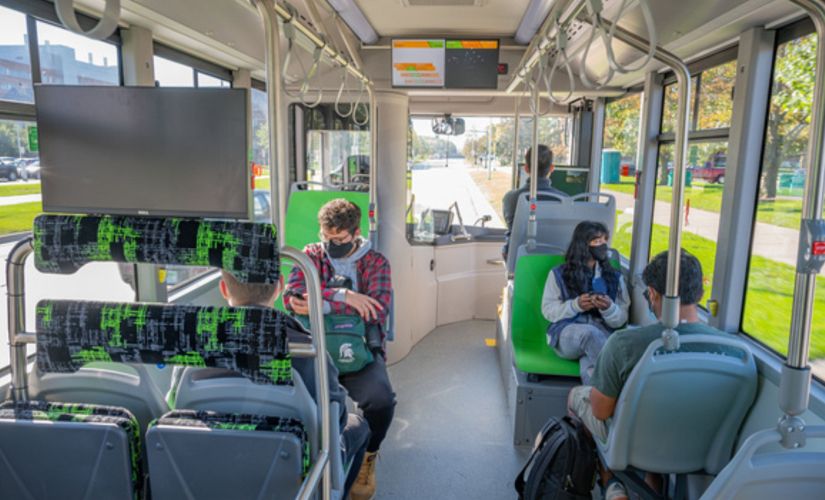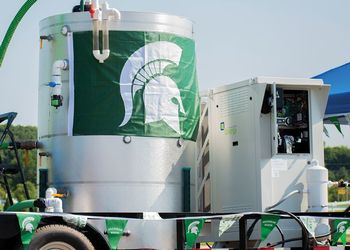Go Green and Go Autonomous

Go Green and Go Autonomous
February 6, 2022Magic Bus
In November, MSU introduced an electric autonomous bus—the Karsan Autonomous e-ATAK bus—that will serve students, staff, faculty, visitors, and mascots in 2022.
An electric autonomous bus will serve students, staff and faculty beginning in 2022 as part of the campus’ smart mobility ecosystem. The bus represents one of the largest electric autonomous transit vehicles to be deployed on U.S. roadways to date. The bus’s 2.5-mile route will run non-stop, roundtrip from the MSU Auditorium to the MSU Commuter Lot (#89) at the intersection of Farm Lane and Mt. Hope, which houses the largest solar carport array in North America.

Learn more: go.msu.edu/auto-bus
Greener Vehicles from Plants

Spartan engineers and Ford Motor Co. are creating new polymers and composites for the automotive industry using sustainable materials from nature.
As a building material, bamboo is pretty amazing. Even though it’s technically a grass, bamboo’s reeds can be tougher than timber. It also grows fast, helping make it more sustainable than lumber.
None of this is a secret to environmentally conscious consumers who have welcomed bamboo into their homes as desks, flooring and cutting boards, to name just a few applications. Still, as ubiquitous as bamboo is, people might be surprised to find it in their cars, which could be a reality in the not-too-distant future.
That’s the future that researchers at Michigan State University and collaborators in the automotive industry—especially at Ford Motor Co.—are working to create. Not just with bamboo, but an array of other plant materials to help cut costs and carbon emissions while making cars and trucks.
Lawrence Drzal, a University Distinguished Professor in the?College of Engineering Department of Chemical Engineering and Materials Science, has been working to reduce the cost of composites used in cars for decades.
In terms of grasses that are attractive for automakers, Drzal and his team have focused on a half dozen—the fantastic six, Drzal calls them—that grow around the world. “You don’t want to be shipping fibers from all around the world,” Drzal says. “You want to utilize plants grown in your backyard.” There are plenty of vehicle parts that could be made from biofiber reinforced composites like sheet molding compound, he adds, mostly in the interior of vehicles.
Learn more: go.msu.edu/plants
Connected Cars
For an engineer who spends so much time with his head in the cloud, Michigan State University’s?Zhaojian Li?is remarkably grounded.
Li is taking today’s high technology—pairing cloud computing with 5G cellular data networks—and putting it to work for the average driver. With the support of a 2021 National Science Foundation CAREER grant, Li and his team are connecting vehicles with the cloud to make roads safer and improve cars’ performance and ride comfort.
“The general idea is to combine the resources of the on-road vehicles and the cloud,” says Li, an assistant professor in the?Department of Mechanical Engineering?and the?Department of Electrical and Computer Engineering. “By using cloud computing, we create more possibilities. It opens up better control and performance for all the vehicles that are connected. The goal is to make vehicles safer and greener.”
For example, say one vehicle runs over a pothole or a patch of black ice. Its onboard sensors would register those road conditions and react accordingly by adjusting the car’s suspension settings or engaging its traction control. But Li doesn’t want the data’s utility to end there.
He wants that car to beam its data to the cloud, which is a collection of online systems for data storage, sharing and analysis. The cloud could then distribute that data to other vehicles, allowing them to preemptively engage controls for a variety of road and traffic conditions to improve the fleet’s safety, comfort and fuel economy. Li’s team is essentially creating a network of automobiles that look out for each other.
“We’re not saying you would trust your brake response to the cloud. The driver will still be in control of things like that,” Li says. “But for things that don’t need a real-time response, we can outsource a lot of that to the cloud.”
Learn more: go.msu.edu/cloud-car




